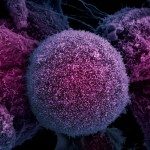Lien vers Pubmed [PMID] – 28362428
Cell Death Differ. 2017 Jun;24(6):1017-1028
p53 functions to induce cellular senescence, which is incompatible with self-renewal of pluripotent stem cells such as induced pluripotent stem cells (iPSC) and embryonic stem cells (ESC). However, p53 also has essential roles in these cells through DNA damage repair for maintaining genomic integrity and high sensitivity to apoptosis for eliminating severely damaged cells. We hypothesized that Δ133p53, a physiological inhibitory p53 isoform, is involved in the balanced regulation of self-renewing capacity, DNA damage repair and apoptosis. We examined 12 lines of human iPSC and their original fibroblasts, as well as three ESC lines, for endogenous protein levels of Δ133p53 and full-length p53 (FL-p53), and mRNA levels of various p53 target genes. While FL-p53 levels in iPSC and ESC widely ranged from below to above those in the fibroblasts, all iPSC and ESC lines expressed elevated levels of Δ133p53. The p53-inducible genes that mediate cellular senescence (p21WAF1, miR-34a, PAI-1 and IGFBP7), but not those for apoptosis (BAX and PUMA) and DNA damage repair (p53R2), were downregulated in iPSC and ESC. Consistent with these endogenous expression profiles, overexpression of Δ133p53 in human fibroblasts preferentially repressed the p53-inducible senescence mediators and significantly enhanced their reprogramming to iPSC. The iPSC lines derived from Δ133p53-overexpressing fibroblasts formed well-differentiated, benign teratomas in immunodeficient mice and had fewer numbers of somatic mutations than an iPSC derived from p53-knocked-down fibroblasts, suggesting that Δ133p53 overexpression is non- or less oncogenic and mutagenic than total inhibition of p53 activities. Overexpressed Δ133p53 prevented FL-p53 from binding to the regulatory regions of p21WAF1and miR-34a promoters, providing a mechanistic basis for its dominant-negative inhibition of a subset of p53 target genes. This study supports the hypothesis that upregulation of Δ133p53 is an endogenous mechanism that facilitates human somatic cells to become self-renewing pluripotent stem cells with maintained apoptotic and DNA repair activities.

